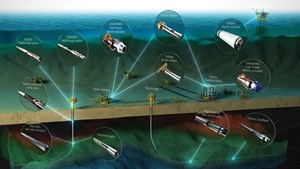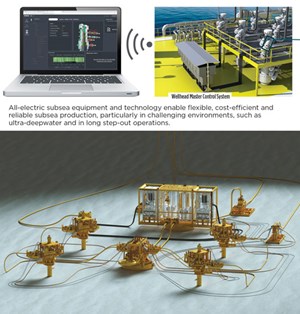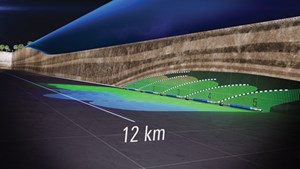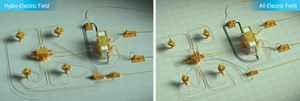Electrifying offshore oil and gas production
Prior to the outbreak of the global pandemic, the call for significant change and transformation of the oil and gas industry was afoot. The impacts of the global pandemic amplified this call to action, serving as the catalyst for fundamental industry changes. Amidst this transformative shift, the industry is facing a new dual imperative—meet current and future demand for oil and gas in a manner that ensures returns-focused performance while reducing carbon footprint.
For offshore oil and gas producers, capital stewardship is translating to an operating environment defined by lower total expenditures. There is a keen focus on reducing CAPEX and OPEX, while also accelerating time to first oil and gas, and enhancing production or total recovery. Underlying all of this is the imperative of reducing the environmental impact of each barrel produced.
To continue to make significant strides toward delivering lower-cost and lower-carbon energy, Schlumberger embraces the production journey with its customers by working with a new mindset. In this model, close and early engagement and collaboration with customers is becoming the norm.
Schlumberger is engaging with operators through open digitally connected collaboration, with their asset always at the center of everything, aligning to their needs for performance. Value is created by living the production journey—responsively, sustainably, predictably and dynamically for the life of the asset.
Through open collaboration, the industry can no longer have a segmented, linear workflow. Operators share their end goal, and service providers help them make the right decisions early for, and throughout, the full life of the asset. Through this workflow, operators can:
- Select the optimum production systems for the lowest total cost and emissions. In essence, service providers actively manage risks associated with system selection, design, delivery and production, and create leaner, cleaner solutions.
- Configure, to optimize CAPEX and reduce OPEX during the production phase. Through this, we create solutions that are fit-for-purpose from the widest selection of innovative and standard technology.
- Deliver solutions that accelerate project execution to achieve first oil faster. This cuts delivery times through a total lifecycle approach to technology innovation, and increases project certainty
- Produce maximum production and recovery at the lowest cost and lowest carbon per barrel. This enhances reservoir access and control to increase production and recovery, reduce waste, reduce emissions and improve safety—for the life of the asset.
This working philosophy is facilitating greater trust and the adoption of novel concepts that are delivering step-changes in performance, and reductions in overall environmental impact. With electric energy systems (Fig. 1), the industry can de-risk the interfaces across the lower-to-upper completion, through the subsea production and processing systems, all the way to topside.

TRANSITION TECHNOLOGY
In June 2021, Schlumberger formally announced its decarbonization plan and its commitment to achieving net-zero greenhouse gas emissions by 2050—across the entire oil and gas value chain. The plan includes actions to address the company’s own emissions and ventures in new low- or zero-carbon energy sources. In addition, the company introduced its Transition Technologies* portfolio, which provides a pathway for oil and gas operators to reduce their own emissions in oil and gas operations.
Comprised of proprietary technologies and solutions, the portfolio helps minimize emissions and reduce energy consumption, as well as address other key sustainability attributes, while simultaneously driving efficiency, reliability and performance. The portfolio is divided into five themes that target various sustainability challenges, including: addressing fugitive emissions; minimizing drilling carbon footprint; reducing or eliminating flaring; full-field development solutions; and electrification of infrastructure.
For offshore operations, the electrification of infrastructure, and the deployment of all-electric systems, are enabling the industry to deliver lower-cost, lower-carbon energy. Electrification enables sustainability benefits at multiple levels, including utilization of lower-carbon energy sources, reducing operational footprint, aligning with broader platform electrification objectives, and extending reservoir drainage from a single well.

By transitioning large-scale power systems used for offshore operations to run on electric power versus diesel generators, operators can power infrastructure utilizing low-carbon energy sources, including renewable power. All-electric production systems are comprised of a wide range of integrated technologies, spanning subsurface, subsea and surface environments. Electrification also accelerates digitalization, which leads to faster response times at scale, and maximizing value of remote operations. In addition, all-electric systems have inherently smaller footprints, which translates to reduced emissions from manufacturing, installation, operation and maintenance of production systems.
A strong example of a transition technology under the electrification of infrastructure theme is the all-electric surface actuator, Fig. 2. With no reliance on hydraulic fluid, all-electric actuators reduce the risk of fluid discharge to the environment and also help operators to lower OPEX by up to 30%. This is achieved via reliable, long-term remote control of surface valves, as well as condition-based monitoring and money-saving predictive maintenance. Remote operation eliminates unnecessary site visits and personnel on location, so that operators can rethink platform design, such as the removal of costly structures. Reducing maintenance visits and associated travel decreases CO2 emissions, while asset field crews can run leaner, and preventative maintenance operations are better-planned and grouped with other duties rather than being addressed reactively.
THE FUTURE OF OFFSHORE IS ON
Given the strategic priorities now driving the reinvention of offshore oil and gas production, the emergence of all-electric systems is making change both realistic and feasible. The industry has largely relied upon hydraulic production systems for offshore field development. While proven to be effective for many offshore field development applications, it’s widely acknowledged that these systems have limitations and drawbacks from a technical, environmental sustainability and/or cost perspective. In some cases, field development plans are adjusted, based on the feasibility of what a hydraulic system can deliver.
For the offshore industry, reinvention is equating to a push for reliable solutions that ensure predictable lower-cost and lower-carbon production, while unlocking asset value faster. Integral to these efforts are all-electric energy systems, which assist operators in reducing total expenditure, while simultaneously accelerating digital transformation efforts and reducing the carbon intensity per barrel produced. As a lighter, more agile solution, all-electric production systems are a lower-carbon intensity alternative to the hydraulically-powered production systems supporting a large portion of offshore production today.

With an increased focus on unlocking maximum asset potential, the step-change in technological capability provided by all-electric systems enhances production and recovery efforts by enabling extended reach. Greater reach allows for production from complex wells through the employment of multiple, controlled production intervals or multiple multi-lateral branches with lateral multi-zone control from one main wellbore, Fig. 3. While this optimizes production potential, it also decreases the number of wells required for a particular reservoir drainage objective. This, in turn, reduces overall development costs and schedules, which allows for expansion of assets without the addition of new infrastructure—effectively lowering CAPEX while maximizing asset potential.
Electrification also enables the possibility to tie back new wells over very long distances from existing offshore infrastructure. Hydraulic systems rely on hydraulic extension for reach, but face pressure transmission limitations, particularly for extended tie-backs and long step-outs. Hydraulic systems are also limited, because topside pressure-generation capabilities can be quickly exceeded, which results in a need for costly and time-consuming upgrades that may not even be feasible, due to space constraints. All-electric systems, in comparison, offer the ability to transmit power over long distances before reaching technical limitations, which enables the addition of subsea wells to reach reservoir pockets further out from an existing production. This reduces ancillary subsea infrastructure, which significantly optimizes CAPEX spending and operational time.
To improve operational decision-making, all-electric systems enable large numbers of monitoring or control stations deployed along a single cable, whereas hydraulic systems require dedicated lines for each control station, in addition to monitoring lines for sensors. For control, the electric motors used to power downhole flow control valves are operated through high-temperature electronics that monitor dozens of parameters to control the movement. This provides intrinsic data for position (motor resolvers), torque (consumed current), and many other internal parameters that are used for continuous prognostic health monitoring.

Along with sensors, permanent downhole pressure and temperature gauges can be distributed strategically to provide reservoir and choking pressure, Fig. 4. This enables commingling of production from heterogeneous reservoir layers, while preventing crossflow and containing water production. While not new, electrification is expanding the use of downhole pressure gauges, now leveraging pressure measurement for reservoir monitoring, well performance, or productivity index calculations.
This is also where electrification and digitalization intersect—electrification expands and amplifies the use of production system monitoring and surveillance; digitalization contextualizes the massive amounts of data acquired via these operations. When electrification and digitalization fully converge—from the sandface to topside—an all-electric system can deliver real-time and in-context data insights from embedded sensing. In addition, electrification enables full downhole equipment control via one wire or a wireless distributed network, providing dynamic precision control and access to automation capabilities across the entire infrastructure.
Large data sets are contextualized via workflow-specific algorithms, and then combined to deliver production optimization scenarios or plans for preserving equipment integrity for long-term reliability and availability.
System integration is critical to unlocking the benefits that come with converging electrification and digitalization, especially given the many interfaces between the sandface, subsea and topside. Schlumberger is working with operators to overcome these challenges by delivering the full range of technology and system integration, thus ensuring optimal performance.

From an environmental sustainability perspective, all-electric systems can help operators in their mission to reduce environmental impact while simultaneously driving high performance. All-electric systems are lighter and smaller, translating to less energy consumption and reduced carbon emission, Fig. 5. In addition, because there is no reliance on hydraulics or hydraulic fluid, the risk of discharge to the environment is eliminated.
FLIPPING THE SWITCH
All-electric technology for the oil and gas industry is not necessarily novel. Schlumberger deployed its first electric downhole pressure gauge in 1972, and these were followed by multiple evolutions of permanent monitoring systems—with the latest generation Metris* gauge having a reliability rating of 100%. In 1998, the first all-electric downhole flow control valve was developed, albeit never installed. Several generations later, and since 2012, more than 50 all-electric flow control stations, connected to intelligent production and reservoir management systems, have been deployed.
Electric intelligent completions. The utilization of an electric intelligent completion system deployed on a single line enables efficient reservoir management, which ultimately leads to improved recovery. The Manara* electric production and reservoir management system delivers downhole permanent monitoring and flow control of multiple zones and compartments in real time, even for multi-lateral applications. This enables control of practically unlimited zones and compartments with full production information from each one. This delivers unprecedented production and reservoir management in heterogeneous or multi-layered reservoirs, extended-reach developments and extreme reservoir contact wells.
Offshore Norway, Equinor made its first deployment of the production and reservoir management system to enhance oil production while reducing project CO2 emissions in an extended-reach well, in Heidrun field. Equinor will use insight into which zones are contributing to production and embrace the ability to tailor flow from each, using six all-electric monitoring and control stations to optimize oil output and minimize water production. Controlling water production with the Manara system will decrease the energy needed to pump treated water back into the reservoir, reducing the CO2 emissions per barrel of oil produced.
All-electric subsea technologies. All-electric subsea and topside equipment and technology enable flexible, cost-efficient and reliable subsea production, particularly in challenging environments, such as ultra-deepwater and in long step-out operations. Electric umbilicals have a smaller cross-section, enabling the manufacturing and spooling of longer continuous lengths and facilitating the use of a smaller installation vessel. This also reduces manufacturing lead times, which lowers costs and helps to simplify transportation logistics. For long step-outs, splices in the umbilical can be reduced or even eliminated.
At the seabed level, OneSubsea®, the subsea technologies, production and processing systems division of Schlumberger, installed the first all-electric subsea tree for TotalEnergies (then Total) in 2008. Second and third generations were installed in 2012 and 2016, with zero failure to date on the electric actuation for millions of hours of operation. Several hundreds of subsea electric actuators have been deployed successfully in various offshore locations. Subsea processing has similarly benefited from full electric equipment over the years as well, beginning with the first subsea electrically driven multiphase pump installed in Lufeng field during 1997.
Offshore Trinidad and Tobago, Schlumberger helped bp achieve first gas, seven months ahead of schedule, in Matapal field. In collaboration with bp, OneSubsea leveraged its experience to deploy its first all-electric manifold and three 10,000-psi subsea trees with integral Vx Omni* subsea multiphase flowmeters. The combination of a block valve manifold design and standard interfacing drop-in-place electric actuators created a simple solution that also demonstrated optimizations during the manufacturing and testing process.
Digitalization of operations. The utilization of all-electric production systems helps to accelerate digitalization efforts, thus enabling production optimization and strategic planning for maintenance and remedial work.
For example, multi-zone compartments may be producing into a single wellbore, which can result in challenging systems dynamics situations, or even potential stability issues. Conventional solutions and methods are not suitable for tuning systems producing from many single wells with different system dynamics. Through to use of intelligent systems and AI, the industry will overcome this problem. Intelligent systems can make recommendations, or directly manage multiple control devices in an optimal manner, in real time, to ensure high-level production objectives from given set points.
Electrification paves the way toward automation, and will eventually drive autonomous operations at some level. By design, electrification uses various internal parameters to control the system. These parameters provide continuous information about the health of the system and of all its individual components. Collecting this into reliability databases helps improve future generations of equipment, while also enabling intelligent maintenance planning with minimal disruption to production plans.
Industry collaborations. To accelerate all-electric transition and address technology gaps directly, Schlumberger is collaborating with operators on a wide range of joint integration and development projects. In Brazil, OneSubsea is working on a project, in conjunction with Equinor, TotalEnergies, and bp, to develop the next generation of electric subsea trees. Also in Brazil, Schlumberger has a technical agreement with TotalEnergies and Petrobras to develop the next-generation all-electric high-flowrate intelligent completion. These collaborations exemplify the industry’s collective focus of ensuring access to lower-cost and lower-carbon energy, reliably.
Other projects include a collaboration with bp and ExxonMobil for development of an all-electric and fiber-optic monitoring, open-hole gravel pack system, and work with Equinor to develop the next-gen subsea pump, to replace the barrier fluid used as coolant and lubricant directly by the processing fluid.
EMBRACING REINVENTION
With an accelerated focus on the strategic priorities of capital stewardship, digitalization and sustainability, it is incumbent upon the industry to embrace reinvention. Electrification of infrastructure, and the deployment of all-electric systems, provide the step-change in reservoir access, control and performance, in addition to the environmental sustainability required to deliver lower-cost and lower-carbon energy production, today.
All-electric systems enable offshore operators to take a systems approach to reduce environmental impact by lowering the overall carbon intensity per barrel produced; enhance production and recovery through enhanced reservoir access and control; reduce total expenditures; and accelerate time to first or incremental oil and gas.
Through an open collaborative approach to asset performance enhancement, the industry can directly address the imperative of meeting current and future demand for oil and gas in a manner that reduces the carbon footprint and also ensures returns-focused performance and results—and is playing a critical role in defining the future of offshore oil and gas production.
*Mark of Schlumberger
- First Oil: A grand plan designed for U.S. offshore leasing (November 2025)
- Industrial Intelligence: At Weatherford, data drives the bit and everything after (October 2025)
- Managed pressure drilling to manage pressure wells: Managed pressure unlocks offshore success (October 2025)
- CygNet enters a new chapter of evolution (September 2025)
- Overcoming extreme challenges: Advanced chemical solutions for offshore oil production integrity (September 2025)
- How AI can close the digital delta and transform legacy oil and gas operations (September 2025)
- Subsea technology- Corrosion monitoring: From failure to success (February 2024)
- Applying ultra-deep LWD resistivity technology successfully in a SAGD operation (May 2019)
- Adoption of wireless intelligent completions advances (May 2019)
- Majors double down as takeaway crunch eases (April 2019)
- What’s new in well logging and formation evaluation (April 2019)
- Qualification of a 20,000-psi subsea BOP: A collaborative approach (February 2019)


